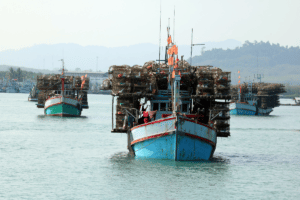Crab fishing is one of the most lucrative jobs in the world. It is also among the most dangerous. Crab fishing boats and large crabbing ships ply their trade in hazardous parts of the world’s ocean, especially in the northern waters off the coast of Alaska. Bad weather, icy waters, and working long hours on boats in rocky sea conditions cause many injuries and deaths aboard crabbing vessels. Though crab fishermen understand certain risks when they accept their jobs, many injuries and deaths are the result of decisions by employers who place profit margins ahead of their crew’s safety during the crab fishing season.

The Dangers of Pursuing the Deadliest Catch
According to the National Institute for Occupational Safety and Health (NIOSH), commercial fishing is one of the most dangerous occupations in the United States. A NIOSH report released in July of 2010 states that an average of 58 deaths a year (128 per 100,000 workers) occurred between 1992 and 2008. These deaths were broken down by types of fishing. Workers who harvested crabs and other shellfish accounted for 226 of the 478 deaths (47%) where the specific type of fishing was known.
There are several reasons why crab fishing is dangerous, especially in the North Pacific Ocean and in the Bering Sea. Crab fishing is mainly done in remote areas of the open ocean close to the Arctic Circle. The season is short; it can last anywhere between a few days to several weeks, usually in the fall and winter months. Most of the U.S. crab fishing fleet is based in Alaska, home of the largest industry-related port, Dutch Harbor. For crab boats, going after what is popularly known as “the Deadliest Catch” involves sailing into an area where the seas are choppy and ice-cold. Visibility during crab season is limited; fog and bad weather are common navigational hazards in the waters between Alaska and Russia. Days are also shorter during crab season, which forces many crab boat masters and their crews to work fast during the few available hours of daylight.
Crew members also face hazards from the vessels and equipment they use. Crab-fishing vessels are usually not large. Their overall length ranges between 39 to 246 ft. (12 – 75 meters). Although the vessels are equipped to withstand the icy waters of the northern oceans, they are cramped. Additionally, crab boat decks are cluttered with heavy equipment, including 800-lb. steel cages called crab pots. Crab pots are lifted and lowered hydraulically, but crewmen are often injured while handling them, especially when hauling the pots back aboard.
Types of Injuries Suffered on Crab Boats
Because they live and work in an environment full of natural and man-made hazards, crab boat crews are at risk of being seriously injured or killed. The most common cause of injuries or deaths is falling overboard. Slick decks, rough seas, and working quickly on a cluttered boat deck cause many of these falls.
Typical injuries on crab boats include:
- Sprains and strains
- Bone fractures to arms and legs
- Skull fractures
- Broken ribs
- Hypothermia
- Frostbite
- Cuts and bruises
- Traumatic brain injuries
- Loss of vision or hearing
- Spinal cord injuries
- Amputations
- Injuries to hands and feet
Common fatal injuries aboard crab boats include drowning (caused by sinkings, capsizes, and deckhands falling overboard), getting caught in crab pot coil lines, and internal injuries caused by falls or contact with heavy equipment.
As mentioned earlier, crab fishermen accept some risks when they seek jobs in the fishing industry. Yet, many of these injuries are due to the negligence and carelessness of other parties. Numerous owners and masters, eager to earn huge payoffs during the short crabbing season, often overload their vessels with equipment and supplies. Often, the pressure to get a huge catch exceeds the employers’ regard for their crews’ safety, and crab boat captains hire inexperienced seamen to get to sea quickly. Several crab boats have also been lost at sea because they were unseaworthy or had stability problems which were overlooked by their owners.
Compensation For Injured Crab Boat Crewmembers
Deckhands and other crewmembers on crab boats are entitled to compensation if they are injured while on the job. Federal maritime law and the Jones Act give injured crab boat crew members the right to file claims against boat owners, masters, or other members of the crew if their injuries were a result of negligence and/or an unseaworthy vessel.